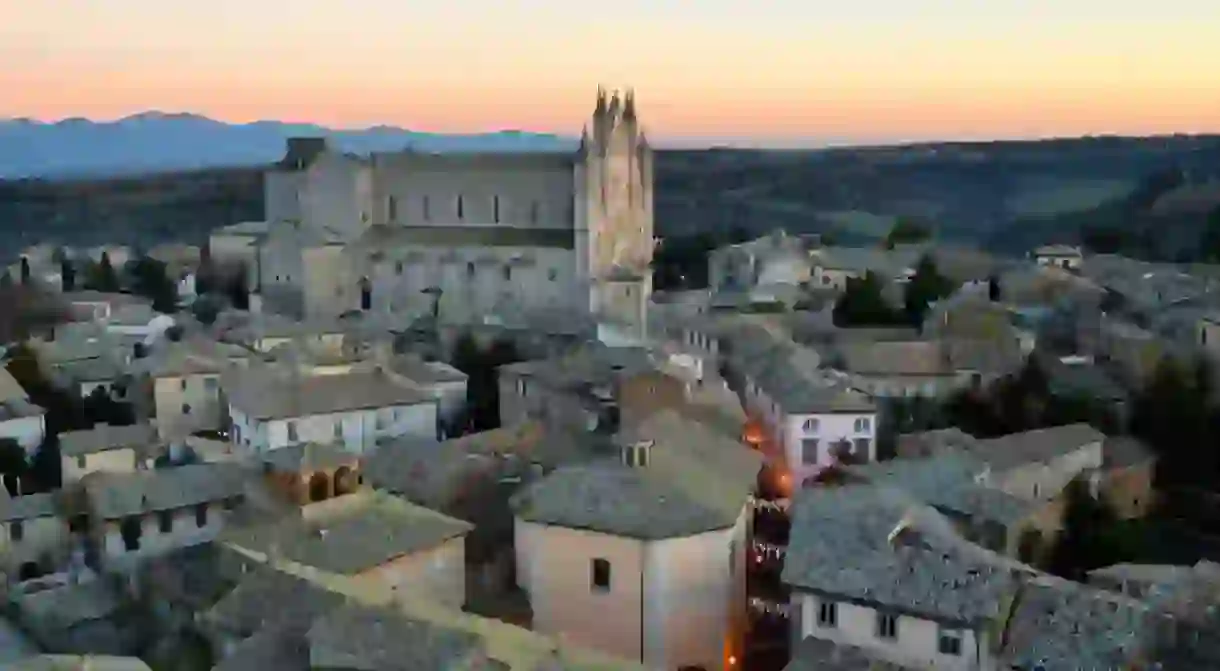Dreamy Italian Hilltop Towns For A Perfect Getaway

Italy is one of the most alluring travel destinations — and for good reason. With its myriad of artistic treasures, unrivaled cuisine, splendid geographical diversity and effusive small town charm, it is a treat for all of the senses. Though its larger cities attract the majority of tourism, no visit to the Italian peninsula would be complete without spending some time in the small hilltop towns and villages that make the country such a special and enthralling place; here are the most beautiful hilltop towns you can’t miss.
Civita di Bagnoregio
This picture-perfect town in northern Lazio is a veritable fairytale come to life. Perched atop a tufa rock hill in the Tiber River Valley, Civita di Bagnoregio emerges out of the terrain like an island in a dream. Originally founded by the Etruscans 2,500 years ago, the town has been largely abandoned due to its friable terrain that has been eroding over the centuries, wistfully earning the town its nickname la città che muore, the dying city. The Civita is connected to the mainland by a footbridge and famously has less than 15 residents year round, though tourism is thriving thanks to its enchanting position and affable charm. Don’t miss the 16th century romanesque church of San Donato in the main piazza with its whitewashed walls and tranquil atmosphere.

Assisi
Best known for being the birthplace of Saint Francis in the 12th century, Assisi is a standout gem in Italy’s central Umbria region. It is the geographical and spiritual center of the St. Francis Way, a walking trail inspired by the life of the saint, and boasts a number of churches that commemorate important events that will be of interest to pilgrims and non-worshippers alike. The 13th century Basilica of St. Francis of Assisi is the focal point of the medieval town and is built on two levels: the upper church, built in Italian Gothic style, is airy and filled with light, while the lower church is dimly lit and closely resembles a crypt with its vaulted ceilings. Both churches are decorated with frescoes by important late Medieval painters such as Cimabue, Pietro Lorenzetti, Simone Martini and Giotto. Assisi has been declared a UNESCO World Heritage Site for its contribution to Italian and European art and architecture.

Brisighella
Brisighella, located in the verdant and fertile Emilia-Romagna region, is a medieval town with defensive walls and a prominent castle fortress at its precipice. The Rocca Manfrediana Castle dates back to the 14th century and continues important works of medieval military art while the nearby clock tower was erected in the 13th century and had similar defensive purposes. Brisighella is a pleasure to walk through for its cobblestone alleyways and contains an ancient elevated street with arched windows that was used by merchants. It is listed as one of the Borghi più belli d’Italia, Italy’s most beautiful villages, and holds a number of festivals throughout the year, making it worth a visit in any season.

Orvieto
The Umbrian town of Orvieto is one of the most delightful destinations in central Italy and a great place for a weekend escape from Rome. With its pedestrian-friendly center, noteworthy sites, dozens of tantalizing restaurants and one of the country’s most formidable cathedrals, Orvieto is a diamond in the rough overshadowed by its more famous Tuscan neighbors. The Duomo di Orvieto rises up above the skyline with its striking facade that musters up particularly stirring emotions at street level for its incongruity with the town’s small and winding alleyways. It is a must-visit for its gorgeous frescoed chapels, particularly Luca Signorelli’s depictions of the Last Judgement, which is said to have inspired some of Michelangelo’s figures in the Sistine Chapel. The lofty Torre del Moro bell tower affords incredible views of the town and Umbrian countryside, which are particularly magnificent at sunset.

Taormina
Sicily’s crown jewel Taormina was inhabited by an Italic tribe during the Iron Age even before the Greeks arrived on the island in 734 BC. With its marvelous location overlooking the Ionian Coast, it has been beloved through millennia and became a well-known tourist destination in the 19th century when German artists and writers such as Wilhelm von Gloeden and Johann Wolfgang Goethe spoke of its praises. In the 20th century, Taormina attracted literary figures such as D.H. Lawrence and Truman Capote, both of whom lived in the same villa, albeit decades apart. Taormina’s main attraction is its ancient 3rd century Greek theater, the second largest in Sicily and one of its best preserved; it continues to be used for operatic and theatrical performances and concerts in the summer months, making for a truly remarkable viewing and listening experience.

Pitigliano
Located in the Maremma region of southern Tuscany, Pitigliano rises dramatically from a tufa ridge with houses built directly into the cliff, blurring where nature begins and ends. Originally inhabited by the Etruscans, the town traded hands between a number of noble families vying for power in central Italy, among them the Orsini family who built the fortified 13th century Palazzo Orsini, which remains a point of interest for visitors. Pitigliano is regarded as “the little Jerusalem” due to the historical presence of a large Jewish community that settled in the town to avoid persecution during the Counter-Reformation in the 16th century. Unlike in bigger cities, the Jews were not initially confined to living in ghettos and were well integrated in the town’s social and economic life until the rise of Fascism and anti-Semetic campaigns began in the lead up to World War II. Today only a handful of Jews still live in the town but their heritage persists through a Synagogue and Jewish cemetery.














